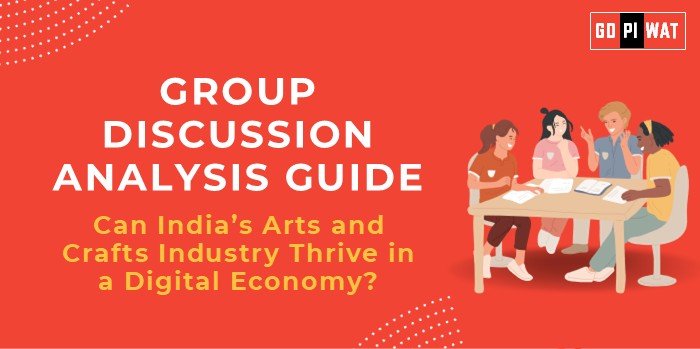🎨 Group Discussion Analysis Guide: Can India’s Arts and Crafts Industry Thrive in a Digital Economy?
📜 Introduction to the Topic
India’s arts and crafts sector, representing centuries of heritage, plays a vital role in cultural tourism and the rural economy. The digital economy, powered by e-commerce and social media, presents an opportunity to redefine its market reach and profitability.
With over 7 million artisans, this labor-intensive industry often struggles with middlemen exploitation and limited market access. Digital platforms can connect artisans directly to global buyers, offering a potential solution.
📊 Quick Facts and Key Statistics
- 👩🎨 Artisans Engaged: Over 7 million depend on crafts for livelihood (Ministry of Textiles, 2023).
- 📈 E-commerce Penetration: Handicrafts sales online grew by 25% in 2023 (MeitY).
- 🌐 Digital Reach: Platforms like Amazon Karigar onboarded 3,000+ artisans in 2022.
- 💰 Export Revenue: Handicrafts contributed $3.5 billion in FY 2023.
🔑 Stakeholders and Their Roles
- 🎨 Artisans: Create and innovate; require support for skills and market access.
- 🏛️ Government: Implements policies like PM Vishwakarma Yojana for funding and digital literacy.
- 💼 Private Companies: Promote digital platforms for direct artisan-buyer interaction.
- 🌍 International NGOs: Support training and global market linkages.
🏆 Achievements and Challenges
Achievements
- 🌎 E-commerce Platforms: Enabled sales in 60+ countries, boosting artisan incomes.
- 📜 Government Support: Initiatives like GI tags promote unique crafts.
- 💳 Digital Payments: UPI simplifies transactions for rural artisans, increasing financial inclusion.
Challenges
- 📶 Digital Divide: Only 20% of rural households have stable internet access.
- 📚 Awareness Gap: Limited knowledge of online tools among artisans.
- 🛠️ Global Competition: Threat from Chinese and Indonesian crafts.
🌏 Global Comparisons and Case Studies
- 🇨🇳 China: Invested in cultural export hubs, generating $10 billion annually.
- 🇻🇳 Vietnam: Integrated handicrafts into tourism strategies.
- 📌 Case Study 1: Rajasthan’s Digital Handicraft Initiative digitized 500+ products, reducing marketing costs by 30%.
- 📌 Case Study 2: Kerala’s Kudumbashree Program successfully marketed traditional crafts via e-commerce.
💬 Structured Arguments for Discussion
- 🟢 Supporting Stance: “Digital tools are revolutionizing India’s arts sector, with online platforms increasing reach and profitability.”
- 🔴 Opposing Stance: “Without resolving the digital divide and logistical barriers, artisans may struggle to realize the benefits of digital tools.”
- ⚖️ Balanced Perspective: “While digital platforms offer immense potential, success requires addressing systemic challenges such as internet access and digital literacy.”
💡 Effective Discussion Approaches
- 📈 Opening Approaches:
- “India’s arts sector employs over 7 million artisans; the potential to digitally transform their lives is massive.”
- “Kerala’s e-commerce success proves how digital tools can enhance artisan outreach.”
- 🤝 Counter-Argument Handling:
- Acknowledge gaps in digital literacy and propose scalable training programs.
- Highlight the importance of public-private partnerships in bridging the digital divide.
📋 Strategic Analysis of Strengths and Weaknesses
- 🏆 Strengths: Unique craftsmanship, growing e-commerce ecosystem.
- ⚠️ Weaknesses: Poor internet access, lack of digital literacy.
- 🌟 Opportunities: Growing demand for sustainable, handmade products globally.
- 🔥 Threats: Rising competition from international markets.
🎓 Connecting with B-School Applications
- 📚 Real-World Applications: Developing scalable digital platforms for artisans can be an MBA project in operations or marketing.
- 📑 Sample Interview Questions:
- “How can the arts and crafts sector integrate with India’s digital economy?”
- “Evaluate the impact of government policies on digital transformation in rural India.”
- 💡 Insights for Students:
- Explore artisan digital entrepreneurship.
- Analyze case studies on public-private collaborations in cultural marketing.


